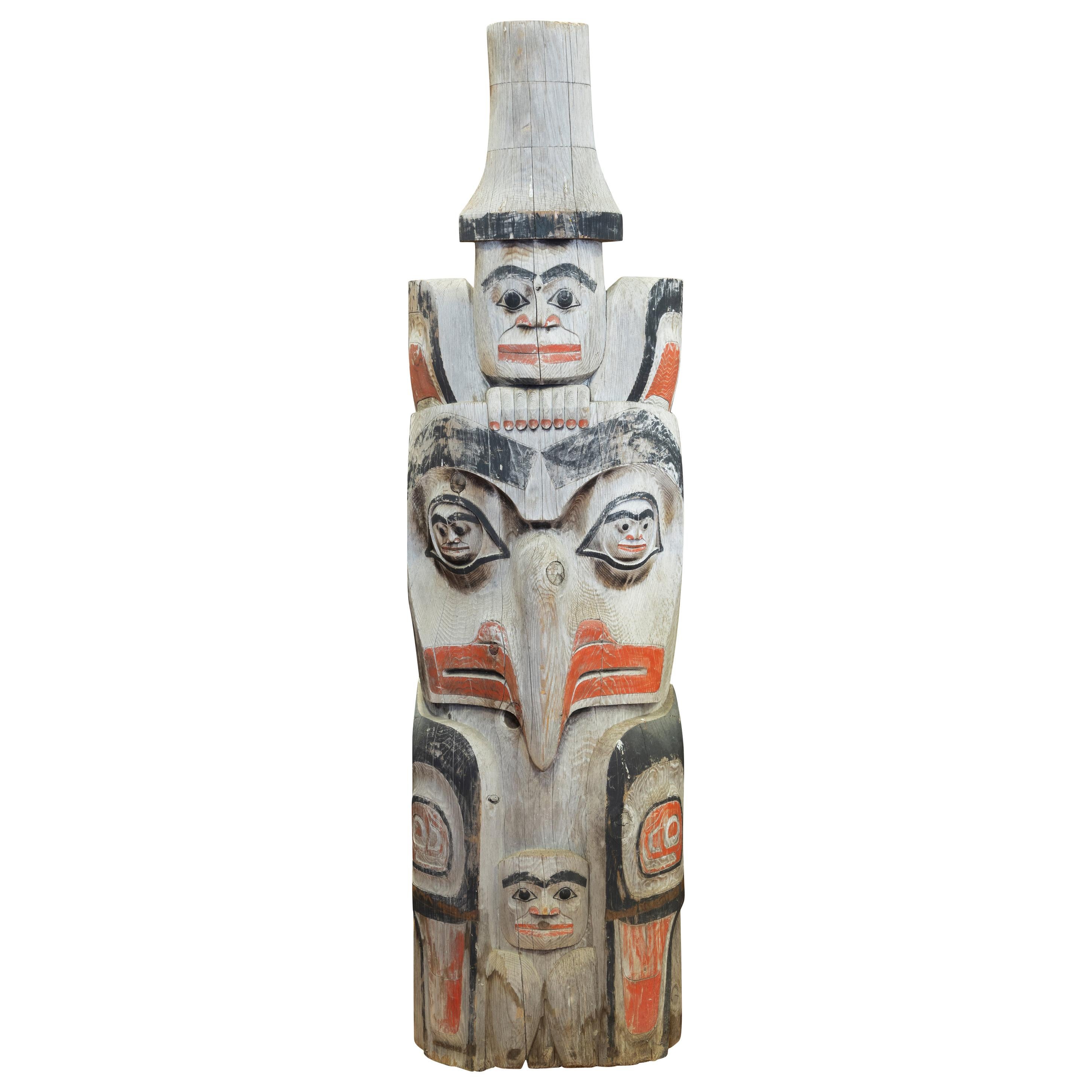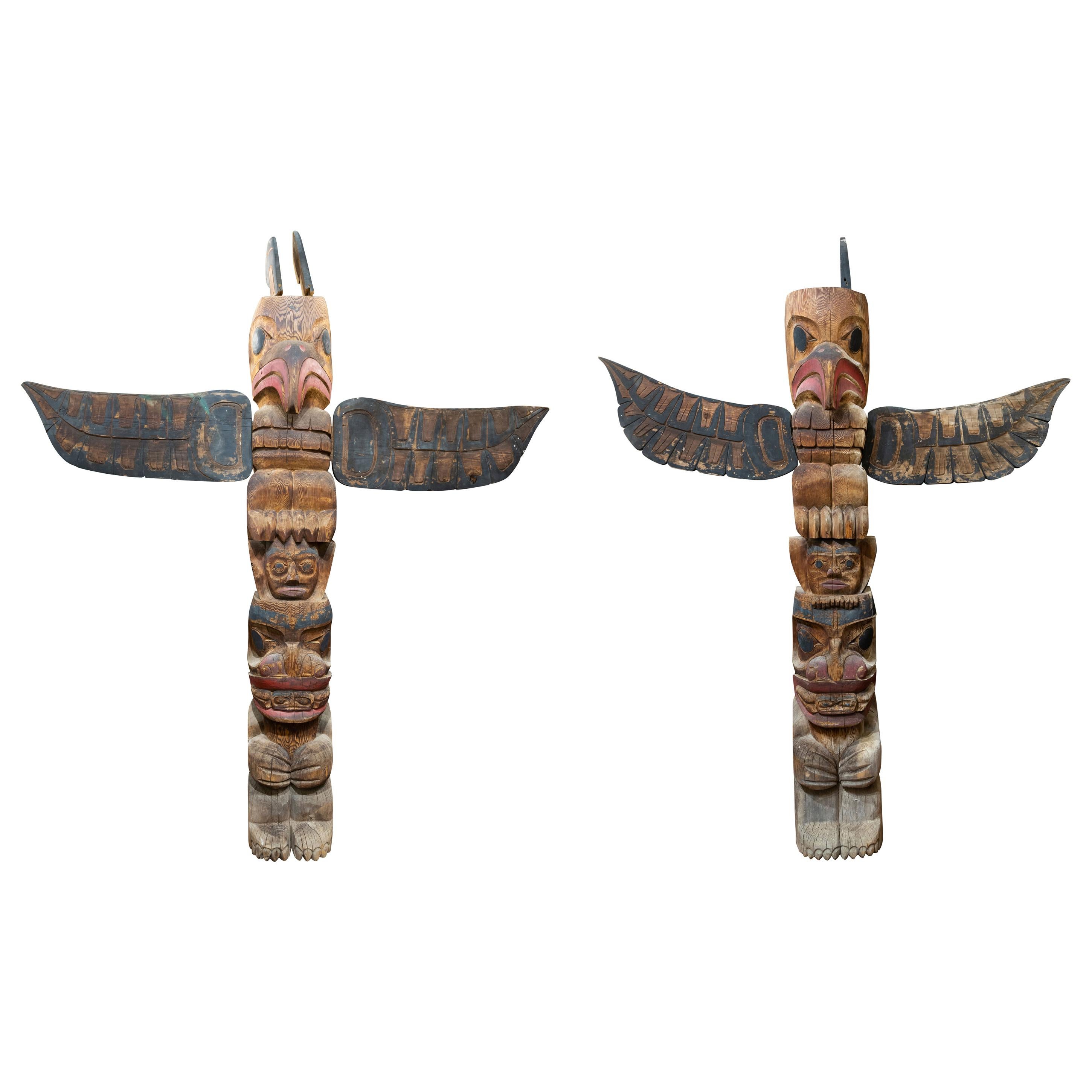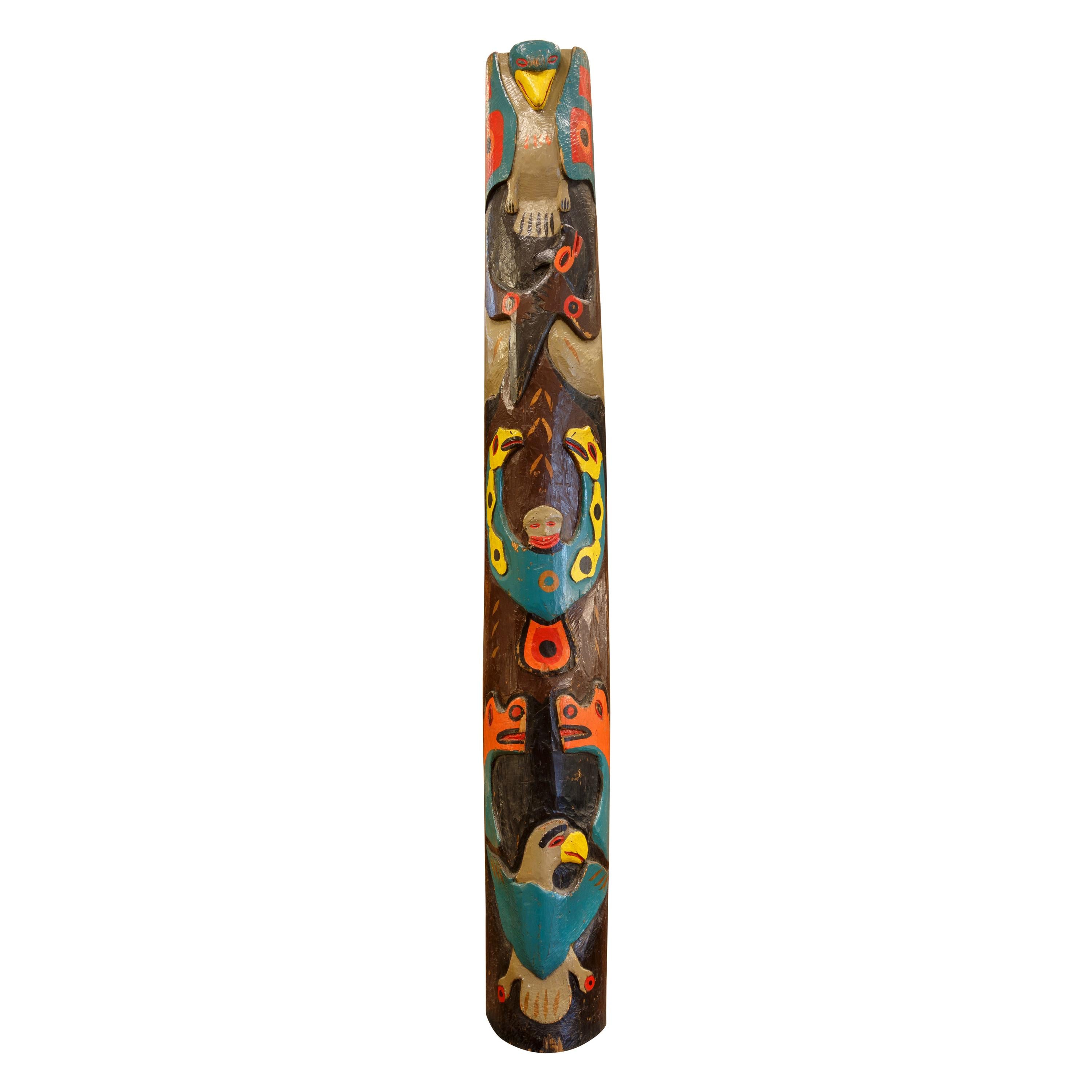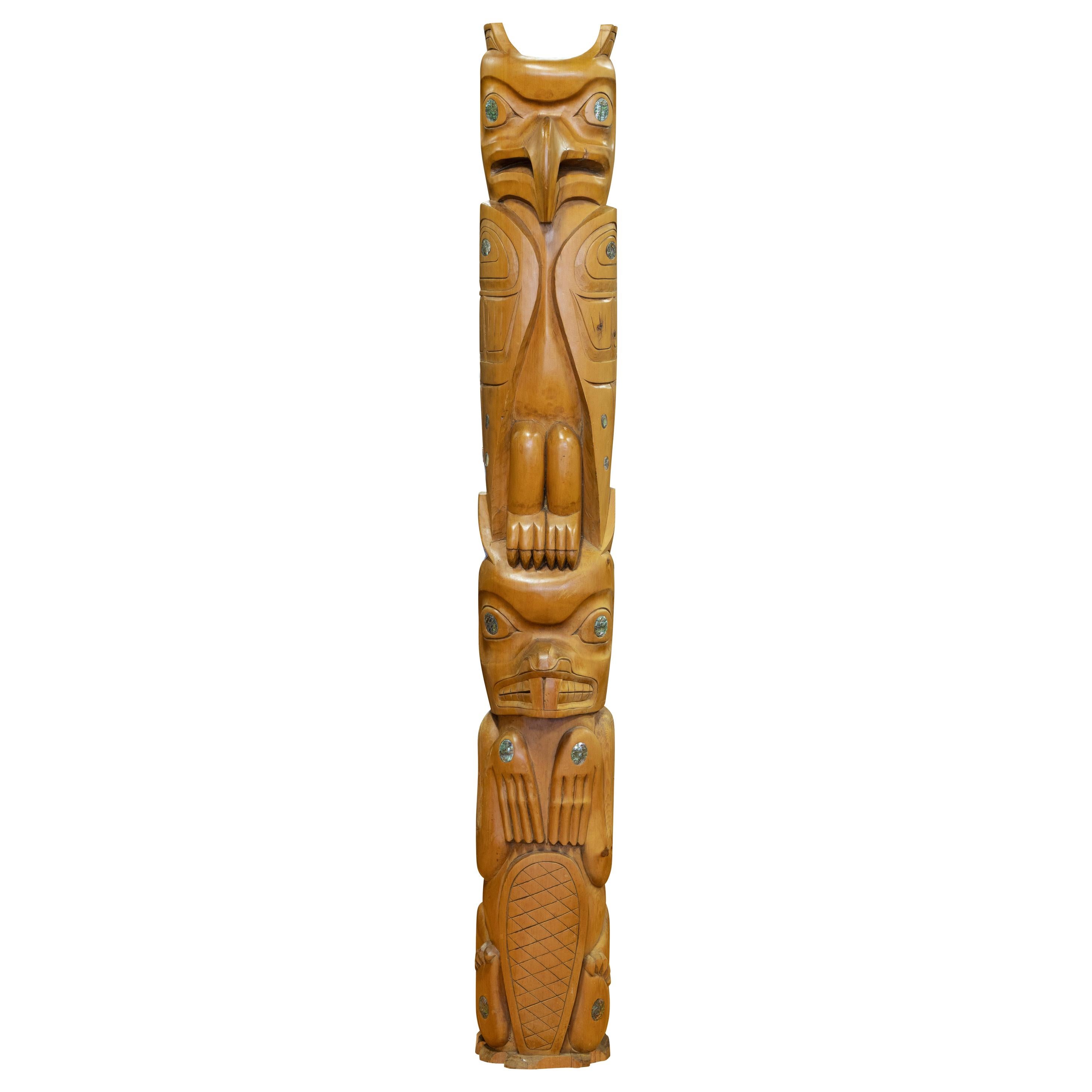Items Similar to Monumental Makah TOTEM by Young Doctor 108"H
Want more images or videos?
Request additional images or videos from the seller
1 of 7
Monumental Makah TOTEM by Young Doctor 108"H
About the Item
Makah TOTEM by Young Doctor (1851-1934). Neah Bay, Washington. This monumental pole is a significant piece of Northwest Coast art and Seattle history that was previously owned by Joseph Edward “Daddy” Standley, the founder of the iconic Ye Olde Curiosity Shop in Seattle, Washington. The pole was displayed for years on the grounds of Standley’s “TOTEM Place” estate in West Seattle, across the bay from his iconic ethnographic art and curio shop on the Seattle Waterfront. So popular amongst tourists was the TOTEM Place estate grounds, that the Southwest Seattle Historical Society has stated that “for decades... it was a place where tour buses stopped, and flashbulbs popped. It probably was the most gawked-at, talked-about residence in West Seattle.”
This pole was even featured in situ at Standley’s West Seattle home on a postcard that was sold to visitors through Ye Olde Curiosity Shop. While there are multitudes of model poles and other artifacts available to collectors that were sold as souvenirs from Ye Olde Curiosity Shop, objects that were actually owned by Standley are virtually unknown in the art market. The vast majority of objects that Standley esteemed and considered his private collection have remained with his family and descendants and are on permanent display in the store.
Among the objects owned by Standley to make their way into the Smithsonian was a Spirit Canoe sculpture by Makah master carver Young Doctor (1851-1934), the likely carver of this pole. It would appear that Standley and Young Doctor had a good working relationship as a number of pieces, including this TOTEM, an elaborate transformation mask, the aforementioned Spirit Canoe model at NMAI, and a full model set of a Makah whaling crew and canoe were made for Standley by the artist. This large-scale TOTEM pole is an exceptional example of turn-of-the-20th-century Northwest Coast carving and is likely the work of renowned Makah master carver Young Doctor (1851-1934) of Neah Bay, Washington.
The Makah are the southernmost speakers of the Wakashan language family and have strong ties to their neighbours and relatives to the north, the Nuu-chah-nulth. Like their Nuu-chah-nulth relatives, the Makah were historically a whaling culture and dependent on the riches of the Pacific Ocean and the Salish Sea for their livelihood. Young Doctor is probably the most well-known historic Makah carver and was a prolific maker of canoes, model TOTEM poles, figurines, masks, and regalia. He is also known to have created several full-scale TOTEM poles. Young Doctor frequently carved for J.E. Standley (founder of Ye Olde Curiosity Shop) and his work is held in major collections including the Smithsonian National Museum of Natural History (NMNH), the Smithsonian National Museum of the American Indian (NMAI), and the Makah Cultural Centre in his home Community of Neah Bay, Washington.
Young Doctor’s style was Classic Makah and has been tremendously influential on contemporary Makah carvers. His carvings reflected his world on the Olympic Peninsula and often featured cetaceans, humans, thunderbirds, wolves, and bears. Young Doctor often used a white or yellow ground paint, which he would layer with other pigments including burgundy, blue, black, and green. The most distinctive feature of Young Doctor’s style is the prominent almond-shaped eyes with circular pupils that he used on his human faces. These eyes are always outlined with a heavy black line that emphasizes the feature. The original green, yellow, brown, and red paints are still bright and clear on the Standley Pole despite the years it spent being displayed outside in the Seattle weather at TOTEM Place.
The Standley pole features four figures which are, from the top: thunderbird, descending killer whale, human face, and bear. In Makah art, thunderbirds and whales are often depicted together as whales are the preferred prey of the giant thunderbirds. The killer whale, depicted in a descending position on the pole, is the apex predator of the waters that the Makah call home and is a central figure in a number of ancestral Makah stories.
The meaning of the human face on the pole is unclear, but the strong sculptural depth and volumes of its features reflect the affinity of this TOTEM with Makah and Nuu-chah-nulth masks from the late 19th and early 20th centuries. It’s possible that the face represents the carver, an important ancestor, or even Standley himself. Below the human at the base of the pole is the figure of a bear, another animal that is a common sight in the rainforests around Neah Bay and the ancestral territories of the Makah people. It’s possible that this pole tells a specific Makah story, but it’s likely that Standley picked the images himself when he commissioned the pole. It is notable that the images of thunderbird, killer whale, and bear can be seen as representing the worlds of the air, sea, and forest in the Makah universe.
As a standalone Makah carving, this pole is an incredible sculpture that would fit nicely in any museum collection. Combined with its stellar provenance and connection to J.E. Standley and his TOTEM Place estate, this pole is one of the most important Northwest Coast objects to come available on the market in recent years. Additional documentation available.
Period: Circa 1900
Origin: Washington
Size: 9' H x 15" W, Protrudes 16"
Family Owned & Operated
Cisco’s Gallery deals in the rare, exceptional, and one-of-a-kind pieces that define the history of America and the Old West. Our pieces range from American Indian to Cowboy Western and include original items of everyday life, commerce, art, and warfare that tamed America’s frontier. Our 14,000 square foot gallery opened in 1996 in beautiful Coeur d’Alene, Idaho.
Personal Service
Cisco’s operates on old fashioned values – honesty and integrity, and all of our items are backed by our money back guarantee. We appreciate the opportunity to earn your business. Whether you desire assistance with a jewelry purchase, choosing a gift, identification, or even selling – we hope to be your trusted source.
Native American, Totem, Pole, Carving, Painted, Makah
- Creator:Native American Art (Maker)
- Dimensions:Height: 108 in (274.32 cm)Diameter: 16 in (40.64 cm)
- Style:Native American (Of the Period)
- Materials and Techniques:
- Place of Origin:
- Period:1900-1909
- Date of Manufacture:1900
- Condition:Wear consistent with age and use.
- Seller Location:Coeur d'Alene, ID
- Reference Number:
About the Seller
5.0
Gold Seller
These expertly vetted sellers are highly rated and consistently exceed customer expectations.
Established in 1996
1stDibs seller since 2018
204 sales on 1stDibs
Typical response time: 3 hours
- ShippingRetrieving quote...Ships From: Coeur d'Alene, ID
- Return PolicyA return for this item may be initiated within 14 days of delivery.
More From This SellerView All
- Northwest TOTEMBy Native American ArtLocated in Coeur d'Alene, IDNorthwest totem with whale, man figure (possibly prominent individual within the tribe or society where the hands are shown in a holding position which...Category
Vintage 1930s American Native American Native American Objects
MaterialsCedar
- Salish Carved Cedar TOTEMBy Native American ArtLocated in Coeur d'Alene, IDSalish TOTEM depicting a human wearing a potlatch hat perched between the ears of an eagle at top, a human face in relief for the birds eyes, a small humanoid/bird figure standing at...Category
Late 20th Century American Native American Native American Objects
MaterialsCedar
- Massive Pair Native Salish Carved TotemsBy Native American ArtLocated in Coeur d'Alene, IDMatched pair of Salish Native American totem poles. Both identical. Carved as a thunderbird with spread rings separately carved and attached perched on the head of a human over a sea...Category
Late 20th Century American Native American Native American Objects
MaterialsCedar
- Multi-Figure 7 Foot Nuu-chah-nulth TOTEMBy Native American ArtLocated in Coeur d'Alene, IDThis large pole was “donated to a church on the northern tip of Vancouver Island for a fundraiser” sometime around 1905. The pole is carved in a folk-art style that is correct for the period. The imagery on this pole is quite fascinating and includes a large bird whose wings form the face of a composite creature holding what appears to be a whale or fish. Below that is what appears to be a Sisiutl, or three-headed sea serpent. Under the Sisiutl is a pair of animal heads flanking the pole, perhaps wolves, over a colonial bald eagle. This pole is a large and early Nuu-chah-nulth totem carving...Category
Antique Early 1900s American Native American Native American Objects
MaterialsCedar
- Tsonoqua/Dzunkukwa "Wild Woman of the Woods" TotemBy Native American ArtLocated in Coeur d'Alene, IDTsonoqua/Dzunukwa, “The Wild Woman of the Woods,” is an important ancestor figure to the Kwakwaka’wakw people of British Columbia. A giantess that fills important cultural roles during the potlatch, she is best known as a wealth-bringing being to those who encounter her and as a creature that parents tell their children stories about to make them behave and not venture far from the village – as she is also a cannibal and has been known to snatch stray children from the woods. She is the female counterpart of the male Bak’was, the Kwakwaka’wakw “Wild Man of the Woods.” Tsonoqua is analogous to the Coast Salish Sasq’ets, better known as Sasquatch, the Nuxalk Sniniq (female) and Buks (male), the Tsimshian Ba’oosh, the Haida Gagiit, the Athabaskan Hairy Man (or Woman), and the Tlingit Tl’anaxéedáakw. She is also what a lot of folks would call Bigfoot. This pole is carved in a Coast Salish style but shows several Kwakwaka’wakw influences, so is perhaps better termed a female Sasq’ets pole. This pole shares a lot of stylistic elements with work by the Coast Salish Horne family and was perhaps carved by one of them. The features of the face that identify this pole as a Wild Woman are the tightly squinted eyes, the prominent cheekbones, and the pursed red lips that depict her making her telltale whistling call. Large breasts are created by “split-u” formline elements on her chest, motifs which are repeated (unpainted) on her arms and legs. Her hands and appropriately large feet are rendered naturalistically, and she is depicted in a kneeling position. A very fine example of Northwest Coast carving. Period: Last quarter 20th century Origin: Salish Size: 49"H x 17'W. Family Owned & Operated Cisco’s Gallery deals in the rare, exceptional, and one-of-a-kind pieces that define the history of America and the Old West. Our pieces range from American Indian to Cowboy Western and include original items of everyday life, commerce, art, and warfare that tamed America’s frontier. Our 14,000 square foot gallery opened in 1996 in beautiful Coeur d’Alene, Idaho. Personal Service Cisco’s operates on old fashioned values – honesty and integrity, and all of our items are backed by our money back guarantee. We appreciate the opportunity to earn your business. Whether you desire assistance with a jewelry purchase, choosing a gift, identification, or even selling – we hope to be your trusted source. Native American, Carving, Totem, Pole, Painted, Cedar, Salish IndianCategory
Late 20th Century American Native American Native American Objects
MaterialsCedar
- Doug Lafortune Sr. Salish Carved Wood and Abalone TOTEM PoleBy Native American ArtLocated in Coeur d'Alene, ID72" TOTEM by Doug Lafortune. Salish TOTEM pole of a raven and beaver cedar TOTEM pole. Carved TOTEM pole with abalone and shell inlays. Carved. .72” x 9...Category
Vintage 1950s American Native American Native American Objects
MaterialsCedar
You May Also Like
- Pair of Bronze Triangular Totem Pedestals by Rod KaganBy Rod KaganLocated in San Diego, CAA super cool pair of bronze triangular totem pedestals by Rod Kagan circa 2007. The set can be used as small display pedestals or as decorative...Category
21st Century and Contemporary American Post-Modern Pedestals and Columns
MaterialsBronze
- Heavy cast cement Tiki totem sculptureLocated in Ferndale, MICast in cement Tiki totem statue. Remnants of old paint.Category
Mid-20th Century American Mid-Century Modern Garden Ornaments
MaterialsCement
- Monumental Travertine PedestalLocated in Pasadena, CAImpressively scaled custom travertine pedestal, circa 1990's, This piece came from the estate of longtime Jeopardy post Alex Trebek.Category
1990s American Pedestals and Columns
MaterialsTravertine
- Monumental Pair of ColumnsLocated in Greding, DEMonumental Pair of Columns on polygonal pedestals with round bases and smooth shafts.Category
20th Century European Pedestals and Columns
MaterialsStoneware
- Monumental Pair of Gilt Bronze Mounted Marble PedestalLocated in New York, NYA fine quality monumental pair of gilt bronze mounted marble pedestal with Corinthian capitol Origin: French Date: 19th century Dimension: 54 1/4 in x 12 1/2 in.Category
Antique 19th Century French Pedestals and Columns
MaterialsGriotte Marble, Bronze
- Pair Monumental Figural Supports Columns Sculptures Representing Atlas HerculesLocated in Antwerp, BETwo carved of oak columns or pedestals, each of a muscular male figure, representing Atlas or Hercules, the head inclined forward and supporting as well with the shoulders a square p...Category
Early 20th Century Italian Art Deco Pedestals and Columns
MaterialsWood
Recently Viewed
View AllMore Ways To Browse
Antique Native American Possible Or Teepee Bag
American Or Martinsville
American Made
United States Of America
Antique America
America Antique
American Antique
Antique Furniture America
Antique American Furniture
America Antique Furniture
American Antique Furniture
H Moster
American Made Furniture
19th Century American Furniture
Antique Early American Furniture
Early American Antique Furniture
19th Century American Antique Furniture
American Furniture W





